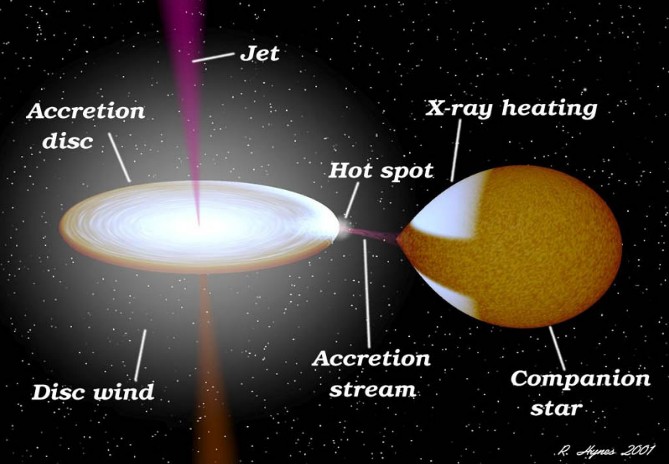X-Ray Versión en Ingles
The aim of this project is the monitoring of a special type of X-ray binaries, also known as microquasars, at radio wavelengths. An X-ray binary consists of a compact object (black hole or neutron star) and a "normal" star, swallowed by the compact object. Some of these systems show radio bursts and their study can give us information about the black hole/neutron star, accretion rate, etc. Students will perform observations of a few selected microquasars to obtain a long-term data set of their radio fluxes, searching for flares. Students will then participate in a "Radio Burst Patrol", rendering the scientific community a valuable service.
X Rays binaries
Binary star systems contain two stars that orbit around their common center of mass. A special class of binary stars is the X-ray binaries, so-called because they emit X-rays. The brightest X-ray sources in our galaxy are X-ray binaries. X-ray binaries are made up of a normal star and a collapsed star (a white dwarf, neutron star, or black hole). These systems produce X-rays if the stars are close enough together that material is pulled off the normal star by the gravity of the dense, compact star. Material is drawn from the normal star and spirals in via an accretion disk onto the compact companion. Intense X-ray emission is released from the inner region of the accretion disk where it falls onto the collapsed star. The X-rays come from the area around the compact companion where the infalling material is heated to very high temperatures (over a million degrees!).
X-ray binaries are further subdivided into several and sometimes overlapping subclasses, that perhaps reflect the underlying physics better. Note that the classification by mass (high, intermediate, low) refers to the optically visible donor, not to the compact X-ray emitting accretor.

Representation of an X-ray binary. (Credit: NASA/R. Hynes)
If the companion to the compact object has a mass of less than or equal to the sun (1 solar mass is 2 x 1030 kg.), then it is called a Low-Mass X-Ray Binary (LMXB). Note that the compact object may still be a neutron star or a black hole) and if the mass of the companion exceeds 10 solar masses, then it is referred to as a High-Mass X-Ray Binary (HMXB).
Microquasars
A microquasar (or radio emitting X-ray binary) is a smaller version of a quasar. Microquasars are named after quasars, as they have some common characteristics: strong and variable radio emission, often resolvable as a pair of radio jets, and an accretion disk surrounding a compact object which is either a black hole or a neutron star. In quasars, the black hole is supermassive (millions of solar masses); in microquasars, the mass of the compact object is only a few solar masses. In microquasars, the accreted mass comes from a normal star, and the accretion disk is very luminous in the optical and X-ray regions. Microquasars are sometimes called radio-jet X-ray binaries to distinguish them from other X-ray binaries. A part of the radio emission comes from relativistic jets, often showing apparent superluminal motion.
Microquasars are very important for the study of relativistic jets. The jets are formed close to the compact object, and timescales near the compact object are proportional to the mass of the compact object. Therefore, ordinary quasars take centuries to go through variations a microquasar experiences in one day.
Noteworthy microquasars include SS433, in which atomic emission lines are visible from both jets; GRS1915+105, with an especially high jet velocity; the very bright Cygnus X-1; and the microquasar candidate LSI+61303, which has been discovered to emit VHE (Very High Energy) gamma rays.